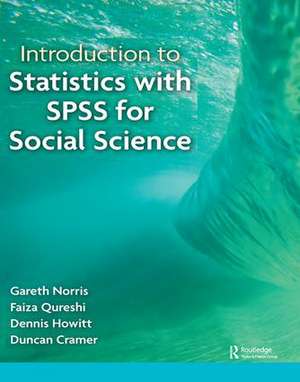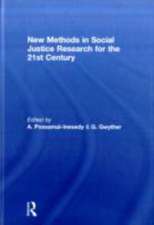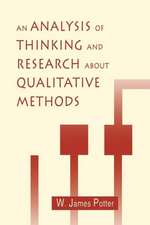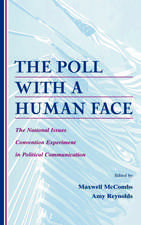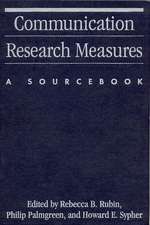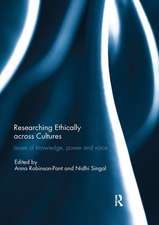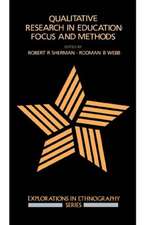Introduction to Statistics with SPSS for Social Science
Autor Faiza Qureshi, Gareth Norris, Dennis Howitt, Duncan Crameren Limba Engleză Hardback – 28 iul 2017
| Toate formatele și edițiile | Preț | Express |
|---|---|---|
| Paperback (1) | 310.05 lei 43-57 zile | |
| Taylor & Francis – 31 mai 2012 | 310.05 lei 43-57 zile | |
| Hardback (1) | 1014.74 lei 43-57 zile | |
| Taylor & Francis – 28 iul 2017 | 1014.74 lei 43-57 zile |
Preț: 1014.74 lei
Preț vechi: 1366.53 lei
-26% Nou
Puncte Express: 1522
Preț estimativ în valută:
194.17€ • 203.24$ • 161.61£
194.17€ • 203.24$ • 161.61£
Carte tipărită la comandă
Livrare economică 31 martie-14 aprilie
Preluare comenzi: 021 569.72.76
Specificații
ISBN-13: 9781138459007
ISBN-10: 1138459003
Pagini: 490
Dimensiuni: 195 x 264 mm
Greutate: 0.45 kg
Ediția:1
Editura: Taylor & Francis
Colecția Routledge
Locul publicării:Oxford, United Kingdom
ISBN-10: 1138459003
Pagini: 490
Dimensiuni: 195 x 264 mm
Greutate: 0.45 kg
Ediția:1
Editura: Taylor & Francis
Colecția Routledge
Locul publicării:Oxford, United Kingdom
Cuprins
Part One Descriptive Statistics. Chapter 1 Why you need statistics: types of data Chapter2 Describing variables: Tables and diagrams Chapter3 Describing variables numerically: averages, variation and spread Chapter4 Shapes of distributions of scores Chapter 5 - Standard deviation, z-scoresand standard error: the standard unit of measurement in statistics Chapter 6 Relationships between two or more variables: diagrams and tables Chapter 7 Correlation coefficients: Pearson correlation and Spearman’s rho Chapter 8 Regression and standard error Part Two: Comparing Two or More Variables and the Analysis of Variance. Chapter 9 - The analysis of a questionnaire/survey project Chapter 10 The related t-test: Comparing two samples of correlated/related scores Chapter 11 the unrelated t-test: comparing two samples of unrelated/uncorrelated scores Chapter 12 Chi-square: Differences between samples of frequency data Part Three: Introduction to Analysis of Variance Chapter 13 Analysis of variance (ANOVA): introduction to one-way unrelated or uncorrelated ANOVA Chapter 14 Two way analysis of variance for unrelated/uncorrelated scores: two studies for the price of one? Chapter 15 Analysis of covariance (ANCOVA): controlling for additional variables Chapter 16 Multivariate analysis of variance (MANOVA)Part Four: More advanced correlational statistics and techniques Chapter 17 - Partial correlation: spurious correlation, third or confounding variables (control variables), suppressor variables Chapter 18 Factor analysis: simplifying complex data Chapter19 Multiple regression and multiple correlation Chapter 20 Multinomial logistic regression: Distinguishing between several differentcategories or groups Chapter 21 - Bionomial logistic regression Chapter 22 - Log-linear methods: The analysis of complex contingency tables
Descriere
A Practical Guide to Software TestingMuch has been written about the difficulty of software testing. Often these laments are accompanied by cautionary words about how careful one has to be to ensure testing is done properly. However, there is a dearth of resources that give practical guidance on the nuts and bolts of testing. Essential Software Testing: A Use-Case Approach describes testing methods and techniques in a common sense manner that is easy to understand, helping readers to quickly and effectively implement project-specific testing solutions.Divided into three parts, the book first discusses ways to make testing agile, providing insight into how testing can be done efficiently in different process environments. Next, the book supplies an overview of testing concepts. Lastly, it demonstrates how to perform the actual test, detailing specific testing activities that can be used on almost any project, with specific attention given to use-case driven testing. It describes how to test using Use Cases regardless of the specific requirements of the project.The author weaves helpful war stories throughout the text, placing the concepts in a concrete framework. This guide gives software testers a firm grasp of all testing fundamentals: how to determine what to test and how to test it, how to select proper tests to match the plan, techniques to build and trace tests, and finally, how to conduct and record tests.
